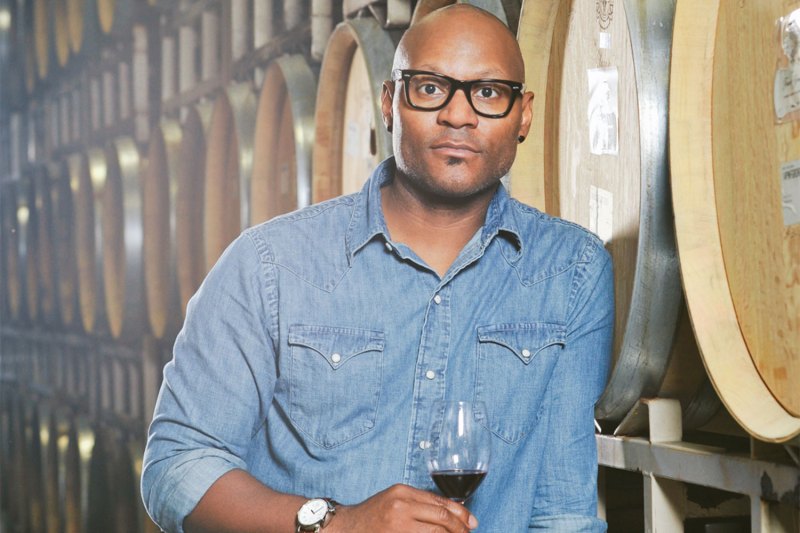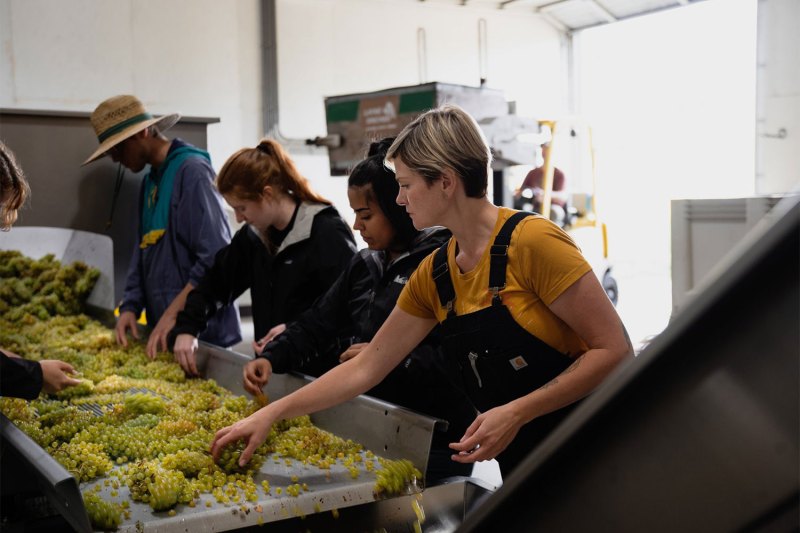If you think winemaking is simply about turning juice into booze once a year, you’re dreaming. Industry folks laugh out loud when they hear such sentiments, aware that the job, while romantic, depends deeply on so many decidedly less romantic things.
Travel has become paramount for wine labels. The winemaker is the face of the brand and as such, is expected to be where the brand is. Consumers, on the other hand, continue to be entranced by being in the company of vintners, amazed that they’re often normal people like you and me and attached to every backstory about how the wines came to be (even if it has nothing to do with the actual winemaking process).
What does this mean for today’s vintner? Red-eye flights from market to market, endless ride-alongs with distributors, trade events, restaurant appearances, and enough opened bottles to give you bowler’s wrist.

André Mack is based in Brooklyn, but you’d hardly know it. The sommelier and winemaker is constantly on the road, whether it’s to check in on his West Coast label — a Willamette Valley outfit called Maison Noir that launched back in 2007 — or to entertain accounts that dot the entire U.S. map.
“I’ve built my company by traveling 47 weeks of a year over the last 12 years,” he says. “I believe the reason why most people buy anything is because they believe in the narrative so at the beginning it was imperative that I get in front of people and tell my story and show the wines.”
Of course, it helps when your brand is both catchy and responsible for some tasty wines. The creative schwag suggests that Maison Noir is certainly the former, while palate-pleasing wines like Other People’s Pinot Gris confirm the latter. But as Mack says, keeping the operation alive and well is about reading the audience as well.

“When calling on a retail shop, I generally like to walk the floor and view the shelves, which gives me a better understanding of what type of buyer I’m dealing with,” Mack adds. “When calling on a restaurant account, I’ll generally ask the buyer to take a look at the menu. Not only do I want to show an interest in the food, but I also get a better insight on what wines I have in my bag I would like to sell them based on the menu.”
“It’s just very important for me to know the people who actually support the wines,” he says. “To be able to share a moment, whether it’s two minutes or two hours — to become familiar and know their story.”
Brianne Day started Day Wines in Dundee, Oregon in 2012. She’s gone from a 125-case-per-year project to a flourishing one with placements in a dozen states and as well as abroad. Her wines are a mix of meticulously worked blends, vineyard-driven Pinot Noirs, and delightful B-side grapes like Chenin Blanc and Malvasia Bianca.

The travel required is a blessing and a burden, especially for a young parent (Mack, too, has children). Day loves the kinship that comes from restaurants and bottle shops loyal to her work. But it’s never easy. In 2019 alone, Day visited nine markets, all with her toddler in tow. “Even without bringing a kiddo along, the sales trips are exhausting,” she says. “We are expected to be on all the time, eating and drinking too much, up late at winemakers dinners and most of the nights. For a closeted introvert like me, it is the hardest part of my job. It exhausts me worse than harvest.”
Fortunately, there’s a lending hand or two in good alliances. “Our distributors do a fantastic job, but there are so many things about the wines, the winery, and the place that really only the winemaker knows,” she admits. After a good visit with a sales team, they’ll come away with answers to questions they didn’t even know they had.
Over her years in the industry, Day has become wiser. She has a ground-up respect for the whole process and understands the many benefits of meeting personally with a sales staff. And she’s become more herself on the road. “I talk about something different with every account and really, truly, am myself,” she says. “I don’t have a filter as much as I used to — people like it when I’m real.”

“Additionally, I speak in very loving terms about the people and places where the fruit comes from. I have a great deal of respect for my growers and their sites,” she continues. “And I want the connection the buyers and reps feel for my brand to deepen as I talk about these details, and not just about my story or how we made the wines.”


